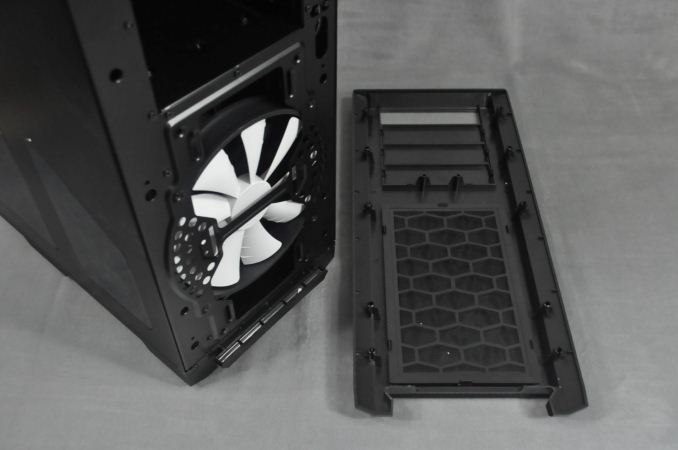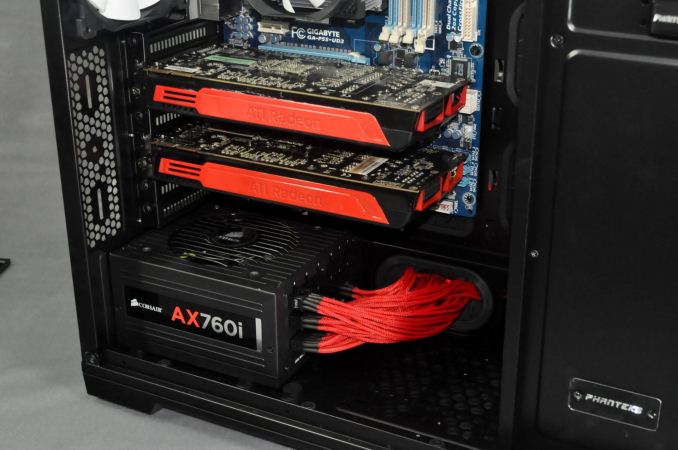The Phanteks Enthoo Pro Case Review
by E. Fylladitakis on March 30, 2015 8:00 AM EST- Posted in
- Cases/Cooling/PSUs
- Full-Tower
- Case
- Phanteks
Conclusion
Phanteks designed the Enthoo Pro to be "beautifully crafted, amazingly flexible, budget friendly and with maximized cooling potential". Of course, it is next to impossible for a product to excel at everything, such as appearance, versatility, quality, performance and value all at the same time. The balance of these five aspects is what actually matters. To that end, we feel that Phanteks hit the nail on the head with the Enthoo Pro, as all five of the main characteristics that define a case are in balance with each other.
Aesthetics are a subjective matter and each person should select a case based on his/her own preferences, in conjunction with the environment that the case will be installed. The Enthoo Pro is a large tower with fairly subtle, modern design; most people should find it sufficiently appealing for their gaming systems and workstations. Although the front panel is actually plastic, its metal-like appearance adds style that only an expert can spot without getting too close. Only the dual side panel window makes the Enthoo Pro a little too "aggressive", while its presence is questionable because of the front window being right on the metallic sidewall, but those seeking a more elegant appearance can select the solid side panel.
The thermal performance of the Enthoo Pro may not be stellar but it certainly is on par with the competition. With just its stock cooling fans, the Enthoo Pro can match and outperform other similarly priced and or sized cases. Even without extra cooling options, the Enthoo Pro can keep a very powerful system sufficiently cool and stable. Also, not only there are numerous slots for extra fans and radiators, but their installation positions are not fixed - they can be shifted on their installation rails, lifting compatibility and versatility even higher.
Finally yet importantly, the Enthoo Pro makes a good compromise between quality and price. Phanteks designed the case well, the materials are very good and the frame is very sturdy, especially if one considers that the chassis can be dismantled. The Enthoo Pro currently retails for $100 with a window, as the one presented in this review, or for $90 with a solid right side panel - shipped. For the features, quality and versatility of the case, its retail price is very competitive, making a high performance, spacious and modular case affordable to the advanced user and seasoned modder.
It is crystal clear that the Enthoo Pro is a great asset for Phanteks - not for its appearance, features or even performance, but for the roomy interior and its modular chassis. The Enthoo Pro is not too expensive, large or complex, yet it is spacious and versatile enough to be a modder's dream case. If the appearance of the Enthoo Pro pleases you and you want a spacious, adaptable and fairly priced case, it should easily find its way among the first places of your shortlist.












50 Comments
View All Comments
Haravikk - Wednesday, April 1, 2015 - link
Agreed. This case is incredibly unremarkable, and until more towers start ditching the obstructive and largely redundant up-front drive bays, we're not going to get much progress in the tower market.I don't know any gamers who really need more than two drives, or for whom 2.5" drives aren't sufficient. 4x 2.5" drive bays can squeeze in almost anywhere in a properly designed case, and would still let you have a pair of mirrored SSDs and mirrored HDDs (or striped if you prefer) which is about the most I expect anyone to have these days.
In terms of optical bays; so few people really use them anymore, meanwhile a slot-loading (or at least low profile) drive takes up hardly any space. The focus really does need to be on big fans up front with as little obstruction as possible.
Some people might mention fan controls, but any good pro case could include one with a custom fitting. But again, most people don't (or shouldn't) need a fan control, as any good motherboard can drive more than enough fans, so at most you might need a splitter cable, especially since most fans these days are pretty energy efficient, especially larger ones that don't need to spin very fast anyway.
So yeah, we're stuck with towers constantly being released with an obsolete internal design, and it's really hurting the market. Only smaller designs are really innovating at the moment, and even then some of them are making really weird decisions.
NLD - Wednesday, September 16, 2015 - link
You don't know because you don't know anyone... I'm a member of a gaming community and know over 50 in our community alone.....NLD - Wednesday, September 16, 2015 - link
get a laptop.Dug - Monday, March 30, 2015 - link
Define R5 lets you take all of them out giving you many options for radiators.NZXT S340 has no bays at all making the case fairly small for an ATX design.
nmm - Monday, March 30, 2015 - link
I would usually agree with you, but I tend to agree with some that the sentiment is more appropriate with compact cases. I just can't imagine there being a realistic need for a tower case with the entire front surface covered with radiators in addition to the top/bottom or whatever else. Just the same, I'd get more use out of a mini-fridge on the front of my case than 5¼" bays. That's because I'm not a person who has any need for a tower case, though. I'd rather build an efficient mini-ITX system than a 3 foot tall air circulator disguised as a computer.WithoutWeakness - Tuesday, March 31, 2015 - link
I think you're on to something with the mini fridge. Most cases with doors only have them to cover the ugly 5.25" bays. If we pull the 5.25" bays and replace them with a mini fridge that can hold a couple of cans then the door would actually have some functional purpose instead of just being for aesthetics.continuum - Tuesday, March 31, 2015 - link
Two went be plenty. Heck, lots of times, agreed that one would be enough, and zero is okay.Given it's an E-ATX case for $100 I don't mind seeing one or two (it's certainly big enough!) but yeah, three seems silly...
DanNeely - Wednesday, April 1, 2015 - link
Once you have a single 5.25 bay, you might as well have several, and a mess of 3.5" bays below, since you've stretched your case forward enough to accommodate them.The compact (front to back) single 5.25 bay case died when the market decided to move the PSU to the bottom and to use the top of the case for ventilation.
NLD - Wednesday, September 16, 2015 - link
5.25 bays are essential , Fan controllers, lighting controllers, Card drives, audio bays.... if you don't like them use the 100's of cases with no 5.25 bays.... I really think new cases need them, maybe more ascetics and innovation on how you can disguise or hide them is a good idea.Needless to say, fans of external Blu-ray players and DVD-HD writers etc... will not care but they are with good cases, 5.25 drive bays will live on.
nos024 - Monday, March 30, 2015 - link
I like my 5.25 bays...there has to be at least two. I am not ready to give up my ODD and swappable HDD bay. At least for large towers like this, I want to have 5.25 bays. I can see a mid tower case not having it. The point of a full tower case is that you can put ANYTHING you want in it.The problem with these large towers case is that the 8pin CPU power cord is barely long enough (and sometimes won't even reach). Given that the majority of PSUs are mounted at the bottom, I think it's time the PSU manufacture give you a longer cord...or the Motherboard manufacturers change it's location, or the case give you a better path. I see that this case has an opening at the top to route the cable to so it won't be a problem.